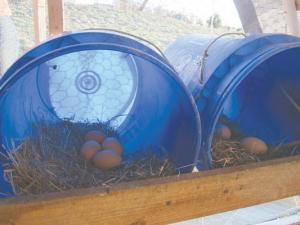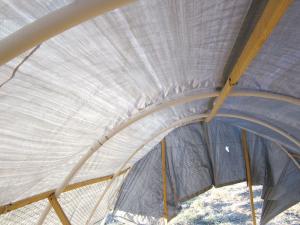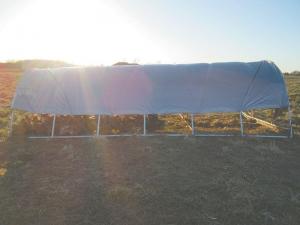Lightweight Chicken House Made From PVC Pipe
When Caleb Howerton of Green Thicket Farm in Springfield, Missouri, started creating designs for pastured chicken housing, he knew it would need to be lightweight for ease of movement but sturdy enough to withstand a lot of handling and a variety of weather. He ended up using pvc pipe, poultry netting, furrowing strips, and heavy-duty tarps.
The chicken “tractors” are 10 ft. wide, 20 ft. long and 6 ft. high. Caleb used 1-in. pvc pipe, along with T and right angle pvc pipe connectors to assemble the 10 by 20-ft. rectangular base; the T connectors were then used to bend seven 15-ft. long sections of the 1-in. pvc across the frame into 6-ft. high hoops, creating a hoop house-like shape.
To stabilize the frame, two 10-ft. pvc crossbars were screwed into the top of the bottom frame – this raised the crossbars just high enough off the ground to support the structure without catching on the ground during a move. Four 4-ft. furrowing strips were attached from the sides of the structure to the bottom crossbars at an angle to provide additional support – two more 4-ft. furrowing strips were attached lengthwise to the angled strips to create roosting bars for the chickens.
The front end of the tractor frames are 3 in. higher than the side runners of the frame to prevent the tractor from catching on anything when it is pulled, and a 5-in. canvas tarpaulin is attached with self-tapping screws to close the gap and prevent chickens from escaping, while still allowing for easy movement.
Once the frame of the chicken tractor was in place, a 4-ft. tall, 2-ft. wide door was built into one end of the tractor with poultry netting, furrowing strips, and a barrel latch. To close in the structure, 4-ft. of poultry netting was stretched around the base and was secured with wire ties. The remaining open roof and side areas were covered with a 10 by 25-ft. tarp that was stretched across the frame and secured with lightweight rope that runs through the tarp grommets. A second rope was run in a zigzag pattern across the top of the coop and down through the poultry netting to keep the tarp from flapping and potentially tearing in strong winds. For nest boxes, Caleb used 5-gal. buckets attached to a 3-ft. board that was then mounted to the frame on either side of the door.
The whole assembly can be moved to fresh pasture daily via a 20-ft. section of lightweight rope with some pieces of old garden hose that serve as handles, and 2 carabiners attached to each end. The rope is clipped to 2 out of 4 eyebolts with 1 1/2- in. long thread and 5/8-in. eyes, and then the whole structure can be moved by a single person to the desired area. Once it is in place, 2-ft. long and 1/2-in. thick rebar stakes can be driven through the eyebolts (one set in each corner) into the ground to keep the structure from shifting in high winds.
Contact: FARM SHOW Followup, Caleb Howerton, 1008 E. Farm Road 54, Springfield, Mo. 65803.

Click here to download page story appeared in.
Click here to read entire issue
Lightweight Chicken House Made From PVC Pipe LIVESTOCK Poultry When Caleb Howerton of Green Thicket Farm in Springfield Missouri started creating designs for pastured chicken housing he knew it would need to be lightweight for ease of movement but sturdy enough to withstand a lot of handling and a variety of weather He ended up using pvc pipe poultry netting furrowing strips and heavy-duty tarps The chicken “tractors” are 10 ft wide 20 ft long and 6 ft high Caleb used 1-in pvc pipe along with T and right angle pvc pipe connectors to assemble the 10 by 20-ft rectangular base; the T connectors were then used to bend seven 15-ft long sections of the 1-in pvc across the frame into 6-ft high hoops creating a hoop house-like shape To stabilize the frame two 10-ft pvc crossbars were screwed into the top of the bottom frame – this raised the crossbars just high enough off the ground to support the structure without catching on the ground during a move Four 4-ft furrowing strips were attached from the sides of the structure to the bottom crossbars at an angle to provide additional support – two more 4-ft furrowing strips were attached lengthwise to the angled strips to create roosting bars for the chickens The front end of the tractor frames are 3 in higher than the side runners of the frame to prevent the tractor from catching on anything when it is pulled and a 5-in canvas tarpaulin is attached with self-tapping screws to close the gap and prevent chickens from escaping while still allowing for easy movement Once the frame of the chicken tractor was in place a 4-ft tall 2-ft wide door was built into one end of the tractor with poultry netting furrowing strips and a barrel latch To close in the structure 4-ft of poultry netting was stretched around the base and was secured with wire ties The remaining open roof and side areas were covered with a 10 by 25-ft tarp that was stretched across the frame and secured with lightweight rope that runs through the tarp grommets A second rope was run in a zigzag pattern across the top of the coop and down through the poultry netting to keep the tarp from flapping and potentially tearing in strong winds For nest boxes Caleb used 5-gal buckets attached to a 3-ft board that was then mounted to the frame on either side of the door The whole assembly can be moved to fresh pasture daily via a 20-ft section of lightweight rope with some pieces of old garden hose that serve as handles and 2 carabiners attached to each end The rope is clipped to 2 out of 4 eyebolts with 1 1/2- in long thread and 5/8-in eyes and then the whole structure can be moved by a single person to the desired area Once it is in place 2-ft long and 1/2-in thick rebar stakes can be driven through the eyebolts one set in each corner into the ground to keep the structure from shifting in high winds Contact: FARM SHOW Followup Caleb Howerton 1008 E Farm Road 54 Springfield Mo 65803
To read the rest of this story, download this issue below or click
here to register with your account number.









